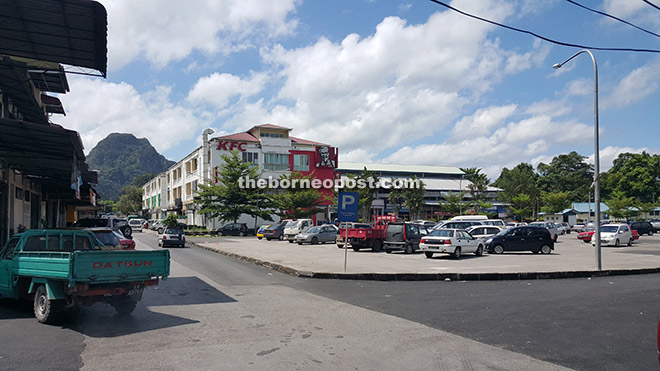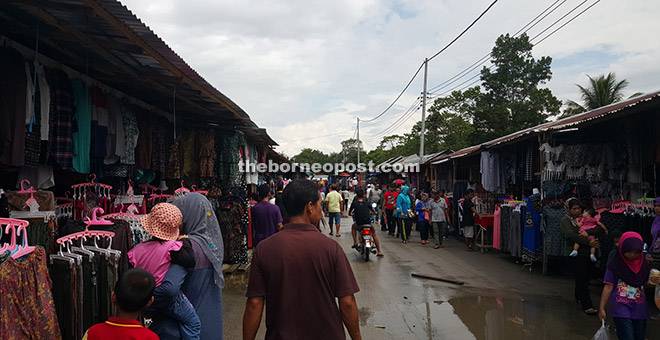
The new Bau town.

The Serikin Weekend Market in Bau.
BEING a small town isn’t always easy. There are many challenges to keeping it vibrant and busy.Even big, star-studded streets or towns face problems but what has kept some of the big towns and streets in the state alive are mega malls, national chains and closed stage bus routes.
Some streets or towns in the state remain ‘sleepy’ or are even ‘drowning.’ Few have successfully rebounded or revitalised.
Bau Town is one that seems to have awakened from a dreamless sleep. Despite its rich historical values and tourism products, it was, at one time, a sleepy hollow as well.
Hawkers, shopkeepers and businessmen blamed it on the Kuching-Bau-Lundu Bypass, completed over 20 years ago.
For about a decade, the town had been in the doldrums, causing even small businesses to struggle. Things, however, seemed to have changed for the better over the past year or so with a big jump in the number of visitors, especially on weekends.
Easy accessibility from outside Bau District is giving the goldmining town renewed mojo. Completion of the Semadang-Skio road has shortened the journey from Serian, Padawan and Penrissen to Bau Town.
If in the past, people from Serian, Padawan and Penrissen had to pass through Mile 7 and Mile 10 to get to Kuching-Bau Road, they now can take a short cut from Semadang-Skio Road.
The road was built following the government’s decision to resettle villagers from four Kampungs in Upper Penrissen, affected by construction of the Bengoh Dam.
The villagers from Kampungs Semban Teleg, Rejoi, Bojong and Taba Sait had already been placed at the Bengoh Resettlement Scheme, midway between Kampung Semadang and Bau Town.
A drive from Kampung Semadang to Bau now takes about 20 minutes.
Of late, Bau Town has not only been welcoming visitors from villages and housing estates within the District during weekends but also from Serian, Padawan and Penrissen.
People from these areas either go to Bau for a change of scene and food, or to Serikin for the weekend market first, before dropping by Bau for some sustenance.
The weekend market at Serikin, a border town, is about 15km from Bau. Every weekend, local and Indonesian traders open their zinc stalls for business.
Traders set up stalls on Saturday morning and pack up on Sunday evening. The market, started in 1992, has attracted both locals and foreigners alike. The stalls, operated mostly by Indonesian traders, offer a variety of colourful fabrics, ornamental wood carvings, rattan handicrafts and many more.
Every weekend, car and busloads of visitors come to check out the merchandise on offer.
Vibrant and lively
I’m not sure about the nightlife in Bau Town but during the day, especially on the weekends in August, the town and the streets had become vibrant and lively with vehicles, people and activities.
Business at food outlets was especially brisk business as thousands flocked to the town.
One of the activities held in August was cleaning up Tasik Biru (Bau Lake or Tai Parit) by gotong-royong.
About 800 people, donning We Love Tasik Biru T-shirts and armed with an array of tools and plastic bags, joined in the community project, launched by Tasik Biru assemblyman Dato Henry Harry Jinep and Serembu assembylman Miro Simuh.
A monument was also unveiled in remembrance of the 31 SMK Lake students who perished after the bus they were travelling in plunged into the lake in a freak accident on July 6, 1979, at about 12.50 pm.
The Bau Transport Company bus was carrying 67 passengers. Twenty-nine pupils and one trainee teacher drowned. Only 37 pupils, the driver and the conductor were rescued.
Bau Town hosted two motorcycle events from August 27-28. Thousands turned up to watch the Bau Bike Week 2016 and Borneo Motocross 2016.
The Bike Week was staged at the parking area within the perimetre of the lake in the town centre while the Borneo Motocross at the racing track in Kampung Serikin along the Sarawak-Kalimantan border, about 40 minutes drive from the town.
On Sept 3, Bau Town was buzzing once again when it hosted the Muaythai Championship. Bouts were held at the parking area near the bus station transformed into a boxing ring.
The hot weather in the morning, followed by a heavy downpour later in the afternoon, failed to turn away the multitude of fans thronging the Bau International Muaythai Cup Challenge 2016.
Up next will be Pesta Tasik Biru or Bau Lake Festival, scheduled at Bau Lake from September 30 to Oct 2.
Tasik Biru transformation team, headed by Harry, is behind all happenings in the District.
Mau San or Bukit Mau
Situated some 35km from Kuching, Bau town is the administrative and trading centre. As a rural district in Kuching Division, it has an area of 884.40 square kms and shares a common boundary with Indonesian Kalimantan.
According to anecdotal evidence, Bau Town was formerly called Mau San or Bukit Mau. European writers during Brooke rule mispronounced the name Bau as Bow.
The town is said to have a historical connection with the destruction of the first Bau Bazaar at Mau San or Bau Lama in 1857. At least a few hundred women and children were said to have been burnt or died of suffocation inside a cavern called Ghost Cave, and about 2,000 people, including the followers of Liu Shanbang, killed in and around Mau San during clashes with James Brooke’s forces.
There were already a few hundred Chinese miners and their families who had established themselves at Mau San under the leadership of Liu Shanbang.
The Chinese settlement at Mau San started between 1820 and 1830 when the discovery of antimony and gold was made known to the Chinese in Sambas, Indonesia.
Back then, the Chinese miners had to travel to Mau San through Pangkalan Tebang. It is said they started exploiting antimony at Paku and Jambusan areas and gold in and around Mau San area.
In addition to their mining activities, some of them planted padi, corn and potatoes around the mining areas.
The miners put up rows of atap, kajang and timber shops on both sides of the Old Bau Road, and residential houses in and around Mau San.
There were at least 4,000 Chinese, mostly Hakkas, in Mau San at the time. It’s believed the Bau Kongsi enjoyed a period of prosperity in early 1850.
By then, gold and antimony mining was not only carried out at Man San area but also extended to Paku, Bidi, Takon and Jambusan areas.
Besides, sundry shops, traditional teashops and lodging houses were also opened at Mau San for the convenience of travellers from Kuching and Sambas.
Big fire of 1978
At that time, Bau was said to be one of the oldest, and perhaps, also the richest, districts in Sarawak in terms of mineral resources. It was not only a well-known mining district but also of great political importance.
Just when the town was to experience steady development, a big fire broke out on September 24, 1978, razing the bazaar to the ground. The tragedy was reportedly the fourth in the history of Bau.
During the incident, most of the 69 wooden shops at Jalan Datuk Salau were destroyed. There were no casualties but about 900 people were made homeless.
There are many interesting mystical stories about Bau. A proper venue is needed to keep and display them for public viewing. Such a place can attract visitors and tourists.
Bau is also popular for its blue lake and two limestone caves. The rock surface outside Fairy Cave is a prime rock-climbing destination of Kuching Division.
Fairy Cave takes its name from a stalagmite at the entrance, said to resemble a Chinese deity.
Inside, you will notice the great contrast between the light entering the cave and its shadowy darkness along with hues of brown and grey rocks, highlighted by rich green mosses, offering many opportunities for the avid photographer.
Another cave is called Wind Cave named after the constant cool breeze blowing through it. Locally known as Gua Angin, it is located about 5km from Bau Town before Lake Secondary School.
The small beach adjacent to Sarawak Kanan River makes it a favourite picnic and swimming spot among day trippers.
